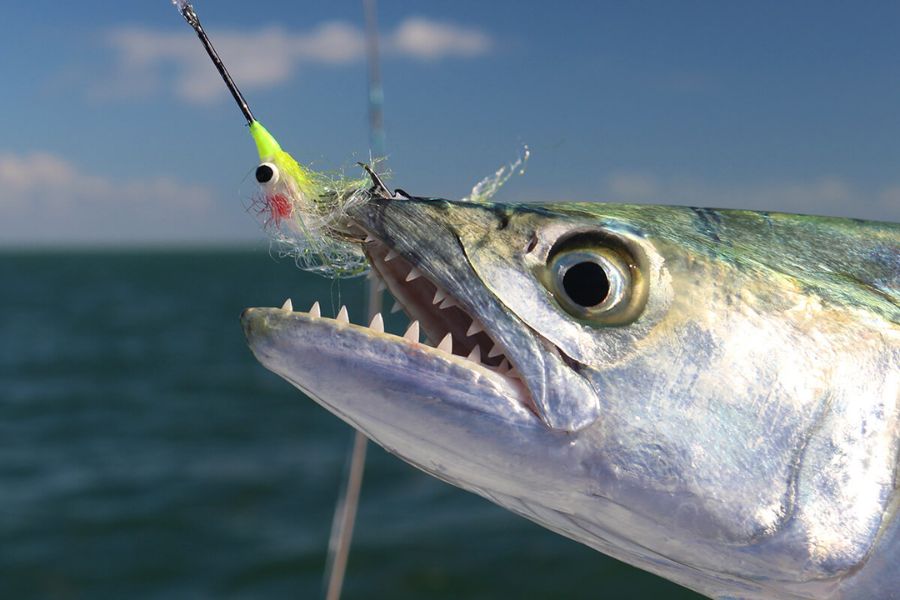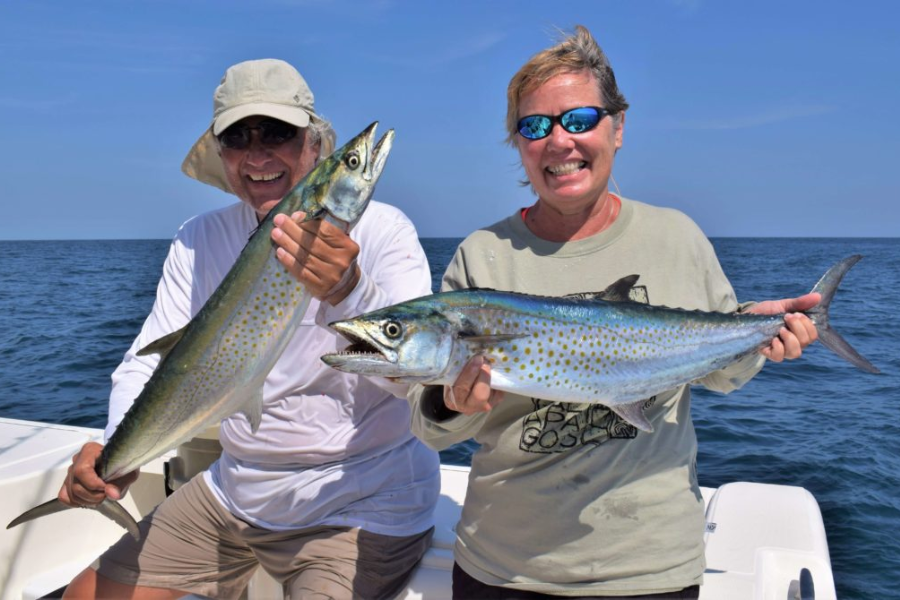Introduction
Among the many species that grace our oceans and coastlines, the sierra fish stands out as a fascinating and efficient predator. Known for its speed, sleek body, and sharp teeth, the sierra fish belongs to the mackerel family and is commonly found in warm coastal waters. Anglers and seafood lovers alike appreciate the sierra fish not only for its taste but also for the thrill it provides during the catch.
Scientific Classification and Origin

The sierra fish, also known scientifically as Scomberomorus sierra, is a member of the Scombridae family. This family includes other fast-swimming species like tunas and bonitos. The Pacific coast of the Americas, extending from Southern California through Central America and Peru, is where the sierra fish is most frequently found. The tropical and subtropical waters in these regions offer an ideal environment for the sierra fish to thrive.
Physical Characteristics and Appearance
The sierra fish boasts a streamlined body covered in small, shiny, silver scales with faint vertical lines and spots that run along its sides. These features allow it to blend into its marine surroundings and evade predators. What makes the sierra fish truly distinctive, however, is its set of razor-sharp teeth, which it uses to hunt smaller fish and crustaceans. Its aerodynamic shape enables it to swim at impressive speeds, making it a challenging catch for fishermen.
Habitat and Distribution
The sierra fish’s wide geographic distribution contributes to its popularity in fishing communities. This species prefers shallow, inshore waters, particularly near reefs, estuaries, and sandy coastlines. It often travels in schools, making it easier to spot during certain times of the year. Because the sierra fish is sensitive to water temperature, it migrates seasonally in search of optimal conditions, which has an impact on its availability for commercial and recreational fishing.
Diet and Hunting Behavior
As a carnivorous species, the sierra fish has a diet consisting mainly of small fish, squid, and crustaceans. It is known for its aggressive hunting style and sharp reflexes. The sierra fish typically hunts near the surface and uses its speed to outmaneuver prey. Its keen eyesight and strong sense of smell make it an effective predator. Because of its place high on the food chain, the sierra fish plays a crucial role in maintaining the ecological balance of its marine environment.
Importance to Coastal Communities
The sierra fish holds considerable value for coastal communities, especially in countries like Mexico, Costa Rica, and Panama. Local fishermen often rely on this species for both livelihood and sustenance. Its high demand in local markets and restaurants makes the sierra fish a key economic resource. Whether sold fresh, smoked, or canned, the sierra fish contributes significantly to the seafood trade in these regions.
Recreational Fishing and Sport
For sport fishing enthusiasts, the sierra fish is a prized catch. Its speed and agility make it a challenging opponent, often requiring skill and patience. Fishing tournaments in Latin America often include the sierra fish as a target species, attracting anglers from around the world. Techniques like trolling and casting with live bait or shiny lures are commonly used to catch sierra fish. Its fighting spirit and spectacular runs make it a favorite among those who fish for sport.
Culinary Uses and Nutritional Value
The sierra fish is not just a thrill to catch—it’s also a delight to eat. With its firm texture and mild flavor, this fish is used in a variety of traditional dishes across Latin America. Whether grilled, pan-fried, or cooked in soups, the sierra fish holds up well to different cooking methods. It’s also rich in omega-3 fatty acids, protein, and essential vitamins, making it a nutritious addition to any diet. Health-conscious consumers appreciate the sierra fish for its lean quality and health benefits.
Conservation Concerns and Overfishing
The sierra fish is threatened by exploitation and habitat deterioration despite its abundance. Because it is often targeted by both commercial and artisanal fisheries, the population can come under pressure, especially during spawning seasons. Some regions have implemented catch limits and seasonal restrictions to protect the sierra fish population. Sustainable fishing practices are vital to ensure that future generations can continue to enjoy this valuable species.
Environmental Role and Ecosystem Impact

The sierra fish serves as an important mid-level predator in marine ecosystems. By controlling populations of smaller fish and invertebrates, it helps maintain a balanced food web. At the same time, it serves as prey for larger predators such as sharks and dolphins. The health of the sierra fish population often indicates the overall well-being of the coastal marine environment, making it a key species in ecosystem monitoring and conservation efforts.
Breeding and Reproductive Habits
Like many fish species, the sierra fish reproduces through external fertilization. Spawning generally occurs during warmer months when ocean temperatures rise.Male sierra fish fertilize the hundreds of eggs that females might throw into the sea.These eggs float in the water column and hatch into larvae, which eventually grow into juvenile fish. Protecting breeding grounds is crucial to ensure the sustainability of the sierra fish population.
Threats from Climate Change
Climate change poses a growing threat to the sierra fish and its habitat. Rising ocean temperatures, changes in salinity, and shifts in current patterns can affect the migration and spawning behavior of the species. Coral bleaching and destruction of coastal ecosystems also impact the availability of food sources for the sierra fish. As such, understanding how climate change affects marine species like the sierra fish is vital for long-term conservation.
How to Identify a Sierra Fish
When fishing or visiting coastal markets, knowing how to identify a sierra fish is essential. Look for a fish with a long, slender body, metallic silver sides, and small yellowish spots. The dorsal fins are usually dark, and the mouth features rows of sharp, pointed teeth. Unlike some similar-looking species, the sierra fish lacks a swim bladder, which is one reason it moves so swiftly through water.
Commercial Fishing Practices
In many parts of Latin America, the sierra fish is caught using gillnets, longlines, and hook-and-line methods. These practices vary in terms of sustainability and impact. While artisanal fishermen often use more selective and environmentally friendly methods, industrial operations can lead to bycatch and habitat destruction. Efforts are being made to promote better fishing techniques to minimize harm while maximizing the economic benefits of harvesting sierra fish.
Aquaculture Potential
Given the high demand and environmental pressures, some researchers are exploring the possibility of farming sierra fish through aquaculture. Though still in its early stages, farming this species could reduce pressure on wild populations while providing a stable and sustainable supply. However, there are challenges, including breeding behavior and specific dietary needs, that must be addressed before large-scale sierra fish aquaculture becomes viable.
Cultural Significance
In coastal cultures, the sierra fish is more than just a food source—it holds symbolic and social significance. Fishermen often pass down stories and techniques for catching this elusive fish from generation to generation. In some areas, festivals and community events revolve around the fishing season for sierra fish, highlighting its role in both economy and culture. This strong cultural connection underscores the importance of protecting and preserving the species.
Regulations and Management
Governments and environmental organizations have begun implementing regulations to protect the sierra fish. These consist of gear limitations, size restrictions, and closed seasons. In Mexico, for instance, specific months are designated as no-fishing periods to allow the fish to breed. These measures are critical to managing sierra fish stocks sustainably and ensuring long-term availability for future generations.
Best Seasons for Fishing Sierra Fish
Timing plays a big role in catching sierra fish. They are most commonly caught between late fall and early spring when water temperatures are moderate and baitfish are plentiful. These seasonal patterns are predictable, allowing fishermen to plan their efforts accordingly. Understanding the best times and locations can improve catch rates and reduce unnecessary stress on the fish population.
Responsible Consumption Tips
If you’re a seafood lover, choosing sustainably caught sierra fish is a responsible choice. Look for certifications or ask your fishmonger about the source of the fish. Supporting small-scale fisheries that use eco-friendly methods helps reduce the environmental impact. By being a conscious consumer, you contribute to the protection of the sierra fish and its habitat.
Conclusion:
The sierra fish is a remarkable marine species that combines beauty, speed, and ecological importance. Whether appreciated for its culinary value, sport-fishing thrill, or role in the marine ecosystem, the sierra fish deserves attention and respect. As we move forward, a collective effort in sustainable fishing and conservation will ensure that this silver torpedo of the sea continues to grace our waters for generations to come.
Get the inside scoop on your favorite stars at grinnos.com
